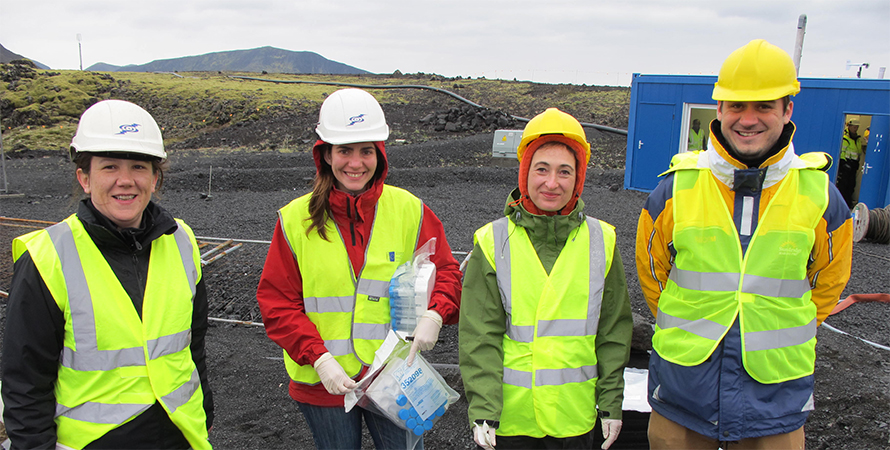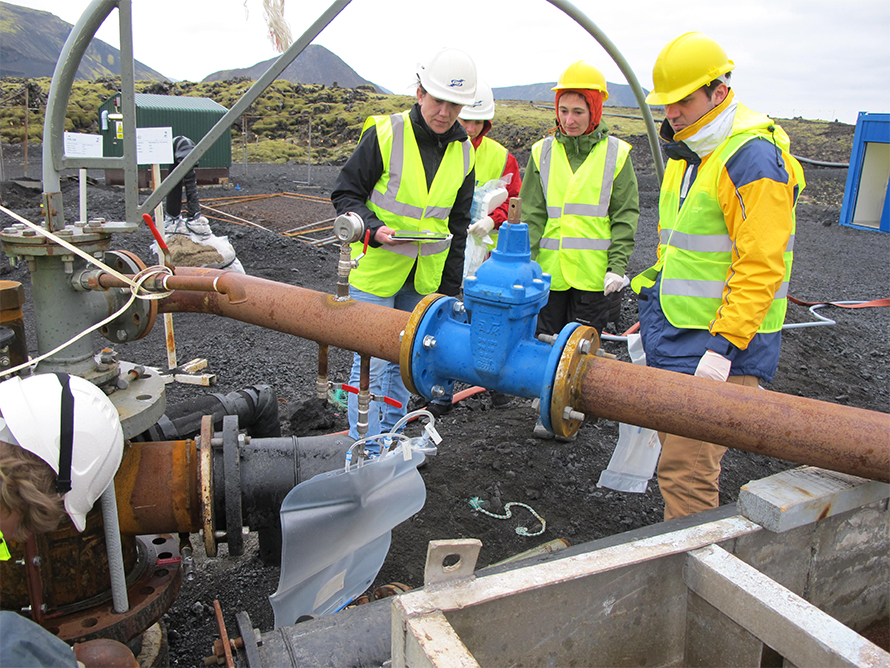
Microbes and minerals
The need for negative emissions, the large-scale removal of carbon dioxide and other greenhouse gases from our atmosphere, has become increasingly important due to their contributions to our warming planet.
According to the NASA, Earth’s surface temperature has risen approximately one degree Celsius since the 19th century, with most of the warming occurring in the last forty years, due to human activity. Another 1.5 to 2˚C increase in global temperature will lead to increases in extreme heat and weather events, rising sea levels, loss of global biodiversity, food shortages and more.
Carbon capture and sequestration, or CCS, technologies aim to capture excess atmospheric carbon dioxide to reduce greenhouse gasses. Geologic storage of CO2 is a process that naturally occurs in Earth’s subsurface. This naturally occurring phenomenon provides a safe and scalable means to reduce CO2 in our atmosphere. CCS technologies still require a global effort in reducing emissions by reducing use of fossil fuels; however, CCS technology can help advance the efforts to reduce global warming.

One method of CCS is carbon mineralization, which involves sequestering CO2 near industrial sites, like coal or geothermal power plants, and converting it into carbonate rock, such as calcium carbonate (chalk). There are two main types of geologic carbon mineralization: underground injection, and weathering in above-ground reactors.
During underground injection, CO2 is captured as it leaves industrial sites and separated using chemical solvents. The captured carbon dioxide is pressurized to form a liquid, mixed with water, and then injected deep into the earth’s metamorphous or igneous rocks, such as basalt. Water added to the pressurized CO2 reacts and forms carbonic acid, a key driver in mineralization. The alkaline minerals in the rocks react with the pressurized CO2 and fluid mixture, forming carbonate solids.
Above-ground mineralization uses reactors that mimic the natural weathering of silicate material. Industrial mineralization is accelerated compared to natural weathering, which occurs over timescales of millions of years.
Most carbon mineralization research is dedicated to understanding its technical challenges and mechanisms as well as methods to improve the process. In contrast, researchers rarely consider the effects carbon mineralization may have on the ecosystems that may exist in these rocks.
In 2017, Emmanuelle Gérard and her colleagues at the Institut de Physique du Globe de Paris were the first to publish a study on the effects of underground carbon dioxide injection on microorganisms in basalt. The study was conducted in 2012 at the Hellisheiði geothermal plant, which lies on an active volcanic ridge in Iceland, encompassing three volcanoes.

Gérard’s research focused on the fast-flow pathway, the arrival of the fastest flowing gas-charged water traveling through fractures and rubble in the basalt 400 to 800 meters below the surface after injection. They looked both at pure carbon dioxide dissolved in water and at a mixture derived from the purification of geothermal gas at Hellisheiði. “Our first idea was just to observe if there were microorganisms,” Gérard said. “(Because of) how we think about carbonate formation, we were not thinking they will help form carbonate. But if they did, it would be good.”
Gérard and her colleagues conducted their work on microorganisms and biodiversity at Hellisheiði during feasibility tests being done by Carbfix, a company focused on using carbon mineralization at industrial sites to reduce carbon dioxide emissions. The goal was to assess overall feasibility and method optimization. Carbfix still partners with the Hellisheiði power plant and is working to adapt and expand this technology into other industries, such as steel, iron and cement production.
The group reported “rapid and large” changes in biodiversity after CO2 injection at high temperatures. Dissolution of basalt released ions such as magnesium, ferrous iron and calcium and stimulated growth of autotrophic and heterotrophic bacteria; these are bacterial species that use CO2 and organic material for food, respectively.
Once the injections passed, the researchers observed a return of the resident bacteria. “We saw the microorganisms were perfectly adapted to each condition,” Gérard said. “These community of bacteria are used to frequent change because they live in an area with natural plumes of volcanic gas. They can adapt to change and return to their normal state.”
In contrast, the injection of the alternate gas mixture made from purified emissions from the geothermal plant (containing CO2, hydrogen and hydrogen sulfide) dramatically shifted the ecosystem in favor of sulfur and iron oxidizing bacteria whose iron sulfate byproduct clogged the reservoir and made it impossible to continue the injection.
Gérard and her team’s research offers insight into one portion of a much larger narrative. “We only have a window to one part of the story,” Gérard said. “We were only able to observe the bacterial communities in the groundwater (or those) attached to the mineral particles in the regions of injection. What is happening to the carbon dioxide at the end of microbial fixation — for example, final storage in calcium carbonate, magnesium carbonate or iron carbonate — remains unknown.”
Gérard and her colleagues tried analyzing mature microbes in deeper regions of rock, but the samples were contaminated with clay, which absorbs DNA, making extraction nearly impossible. Follow-up studies were also increasingly difficult due to COVID-19 travel restrictions in 2020 and 2021.
Nonetheless, since 2017, research has increased in this field, including a 2021 study published in the journal Science of the Total Environment in which above-ground reactors were used to observe the effect of an increasing CO2 gradient on microbial communities. Like Gérard’s group, this study found certain elements of the injection mixture (specifically low versus high CO2) could affect microbial life by suppressing certain bacterial activity and overall biodiversity.
While the research in carbon mineralization demonstrates a clear need to understand more about the impact on microbial life and biodiversity, it also offers a possibility to work alongside microbial life. Can we harness bacteria to enhance the carbon mineralization process?
In a 2017 study published in the Journal of Chemical Biology, scientists evaluated microbial mediated mineralization in sandstone using above-ground mineralization methods. Scientists found that acidic biofilms, clusters of microorganisms that stick to nonbiological surfaces, could accelerate dissolution of silicate minerals in a steel batch reactor. Proteobacteria and Firmicutes were predominant bacteria throughout the process. This suggests certain bacterial species may be useful in enhancing carbon mineralization; however, further research still is needed.
Understanding how the bacteria behave during these injections is important not only because it may be possible to aid carbon mineralization but also because unexpected bacterial blooms or behavior could impede the process.
“I think in every project for CO2 injection into basalt, where life is possible, people should take microorganisms into account — some I am sure will decrease (or increase) mineralization,” Gérard said. “We need to isolate these strains in the lab (helpful, or harmful), to understand their roles better.”
While it remains unclear whether we can harness microbe metabolism to expedite carbon mineralization, it is apparent that these bugs both exist and are greatly perturbed in the process. “I think we need more study, but I hope that we can do something with this technique,” Gérard said. “In Iceland we see it working at high temperatures, but not lower ones. … We need more testing to see if it is a feasible process for reducing CO2 emissions at other sites.”

Enjoy reading ASBMB Today?
Become a member to receive the print edition four times a year and the digital edition monthly.
Learn moreGet the latest from ASBMB Today
Enter your email address, and we’ll send you a weekly email with recent articles, interviews and more.
Latest in Science
Science highlights or most popular articles

E-cigarettes drive irreversible lung damage via free radicals
E-cigarettes are often thought to be safer because they lack many of the carcinogens found in tobacco cigarettes. However, scientists recently found that exposure to e-cigarette vapor can cause severe, irreversible lung damage.

Using DNA barcodes to capture local biodiversity
Undergraduate at the University of California, Santa Barbara, leads citizen science initiative to engage the public in DNA barcoding to catalog local biodiversity, fostering community involvement in science.

Targeting Toxoplasma parasites and their protein accomplices
Researchers identify that a Toxoplasma gondii enzyme drives parasite's survival. Read more about this recent study from the Journal of Lipid Research.

Scavenger protein receptor aids the transport of lipoproteins
Scientists elucidated how two major splice variants of scavenger receptors affect cellular localization in endothelial cells. Read more about this recent study from the Journal of Lipid Research.

Fat cells are a culprit in osteoporosis
Scientists reveal that lipid transfer from bone marrow adipocytes to osteoblasts impairs bone formation by downregulating osteogenic proteins and inducing ferroptosis. Read more about this recent study from the Journal of Lipid Research.

Unraveling oncogenesis: What makes cancer tick?
Learn about the ASBMB 2025 symposium on oncogenic hubs: chromatin regulatory and transcriptional complexes in cancer.

